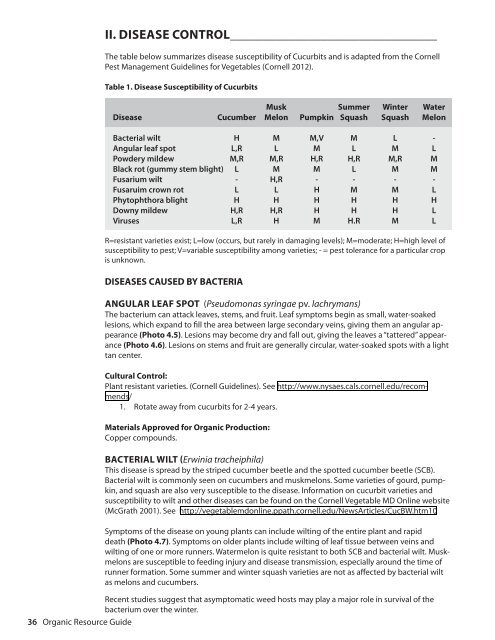Resource Guide for Organic Insect and Disease ... - Cornell University
Resource Guide for Organic Insect and Disease ... - Cornell University
Resource Guide for Organic Insect and Disease ... - Cornell University
You also want an ePaper? Increase the reach of your titles
YUMPU automatically turns print PDFs into web optimized ePapers that Google loves.
II. DISEASE CONTROL________________________________<br />
The table below summarizes disease susceptibility of Cucurbits <strong>and</strong> is adapted from the <strong>Cornell</strong><br />
Pest Management <strong>Guide</strong>lines <strong>for</strong> Vegetables (<strong>Cornell</strong> 2012).<br />
Table 1. <strong>Disease</strong> Susceptibility of Cucurbits<br />
Musk Summer Winter Water<br />
<strong>Disease</strong> Cucumber Melon Pumpkin Squash Squash Melon<br />
Bacterial wilt H M M,V M L -<br />
Angular leaf spot L,R L M L M L<br />
Powdery mildew M,R M,R H,R H,R M,R M<br />
Black rot (gummy stem blight) L M M L M M<br />
Fusarium wilt - H,R - - - -<br />
Fusaruim crown rot L L H M M L<br />
Phytophthora blight H H H H H H<br />
Downy mildew H,R H,R H H H L<br />
Viruses L,R H M H.R M L<br />
R=resistant varieties exist; L=low (occurs, but rarely in damaging levels); M=moderate; H=high level of<br />
susceptibility to pest; V=variable susceptibility among varieties; - = pest tolerance <strong>for</strong> a particular crop<br />
is unknown.<br />
DISEASES CAUSED BY BACTERIA<br />
ANGULAR LEAF SPOT (Pseudomonas syringae pv. lachrymans)<br />
The bacterium can attack leaves, stems, <strong>and</strong> fruit. Leaf symptoms begin as small, water-soaked<br />
lesions, which exp<strong>and</strong> to fill the area between large secondary veins, giving them an angular appearance<br />
(Photo 4.5). Lesions may become dry <strong>and</strong> fall out, giving the leaves a “tattered” appearance<br />
(Photo 4.6). Lesions on stems <strong>and</strong> fruit are generally circular, water-soaked spots with a light<br />
tan center.<br />
Cultural Control:<br />
Plant resistant varieties. (<strong>Cornell</strong> <strong>Guide</strong>lines). See http://www.nysaes.cals.cornell.edu/recommends/<br />
1. Rotate away from cucurbits <strong>for</strong> 2-4 years.<br />
Materials Approved <strong>for</strong> <strong>Organic</strong> Production:<br />
Copper compounds.<br />
BACTERIAL WILT (Erwinia tracheiphila)<br />
This disease is spread by the striped cucumber beetle <strong>and</strong> the spotted cucumber beetle (SCB).<br />
Bacterial wilt is commonly seen on cucumbers <strong>and</strong> muskmelons. Some varieties of gourd, pumpkin,<br />
<strong>and</strong> squash are also very susceptible to the disease. In<strong>for</strong>mation on cucurbit varieties <strong>and</strong><br />
susceptibility to wilt <strong>and</strong> other diseases can be found on the <strong>Cornell</strong> Vegetable MD Online website<br />
(McGrath 2001). See http://vegetablemdonline.ppath.cornell.edu/NewsArticles/CucBW.htm10<br />
Symptoms of the disease on young plants can include wilting of the entire plant <strong>and</strong> rapid<br />
death (Photo 4.7). Symptoms on older plants include wilting of leaf tissue between veins <strong>and</strong><br />
wilting of one or more runners. Watermelon is quite resistant to both SCB <strong>and</strong> bacterial wilt. Muskmelons<br />
are susceptible to feeding injury <strong>and</strong> disease transmission, especially around the time of<br />
runner <strong>for</strong>mation. Some summer <strong>and</strong> winter squash varieties are not as affected by bacterial wilt<br />
as melons <strong>and</strong> cucumbers.<br />
Recent studies suggest that asymptomatic weed hosts may play a major role in survival of the<br />
bacterium over the winter.<br />
36 <strong>Organic</strong> <strong>Resource</strong> <strong>Guide</strong>







